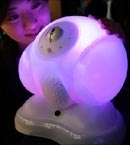Engineers have successfully tested a subsonic drone equipped with a rocket-like engine that can achieve speeds of 11,000 km/h in future commercial flights.
The Venus Aerospace drone during its test flight with the RDRE engine. (Video: Venus Aerospace).
The company Venus Aerospace has completed a test flight of its rocket-based rotating detonation engine (RDRE) equipped drone, allowing the vehicle to reach subsonic speeds. In the future, the company plans to develop ultra-fast commercial jets using this new engine technology. During the test flight on February 24, Venus Aerospace launched a 2.4-meter-long and 136-kilogram drone to an altitude of 3,658 meters using an Aero L-29 Delfín aircraft before deploying the payload and activating the RDRE, as reported by Live Science on April 10.
The drone flew 16 kilometers at a speed of Mach 0.9 (over 1,111 km/h), utilizing 80% of the thrust available from the RDRE. The successful flight demonstrates the feasibility of the rotating detonation rocket engine and its accompanying flight systems. Three weeks prior, Venus Aerospace validated this technology with a long-duration burn test, showing that their engine could operate throughout the flight, producing 544 kilograms of thrust from a combustion chamber with a diameter of about 25.4 cm.
The rotating detonation rocket technology is reportedly 15% more efficient than conventional rocket engines, according to a representative from Venus Aerospace. Theoretically, this means that with the same amount of fuel, an aircraft propelled by this technology could travel further than one powered by traditional engines burning at constant pressure.

The drone flew 16 kilometers at a speed of Mach 0.9 (over 1,111 km/h).
The successful test flight increases the commercial viability of supersonic travel. One of Venus Aerospace’s long-term goals is to develop a commercial supersonic aircraft capable of flying at Mach 9 (11,000 km/h). For comparison, the Concorde could fly at Mach 2 (2,500 km/h), while the prototype Lockheed SR-72 is expected to fly at speeds above Mach 6 (7,400 km/h). A Mach 9 vehicle could travel from London to San Francisco in just one hour.
Similar to the Concorde, which was quite loud during takeoff, the periodic detonations of the RDRE will produce extremely high noise levels. Unlike conventional jet engines that accelerate smoothly, the rapid acceleration cycles based on continuous detonations could increase stress on the engine and its supporting structure.
As RDRE technology has military applications, Venus Aerospace is collaborating with the Defense Advanced Research Projects Agency (DARPA). The company is currently planning additional tests using a larger drone. Engineers are considering installing the RDRE on a larger drone capable of reaching speeds five times faster than sound (6,200 km/h).




















































